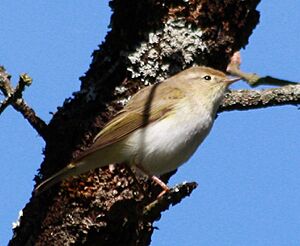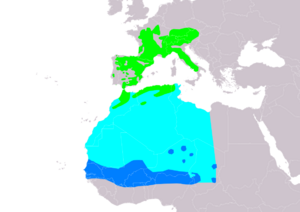Western Bonelli's warbler facts for kids
Quick facts for kids Western Bonelli's warbler |
|
|---|---|
 |
|
| Conservation status | |
| Scientific classification | |
| Genus: |
Phylloscopus
|
| Species: |
bonelli
|
 |
|
| Range of P. bonelli Breeding Passage Non-breeding | |
The Western Bonelli's Warbler (Phylloscopus bonelli) is a small, active warbler bird. It belongs to a group of birds called leaf warblers. For a long time, scientists thought there was just one type of Bonelli's warbler. But now, thanks to modern studies, we know there are actually two different species:
- The Western Bonelli's Warbler (Phylloscopus bonelli), which lives and raises its young in southwest Europe and north Africa.
- The Eastern Bonelli's Warbler (Phylloscopus orientalis), which breeds in southeast Europe and Asia Minor.
These two species do not live in the same areas. While they look very similar and their songs sound alike, their calls are quite different. They also have clear differences in their DNA.
Contents
About the Western Bonelli's Warbler
This bird is a migratory species. This means it travels long distances. During the winter, it flies south to sub-Saharan Africa to find warmer weather and food. It is very rare to see this bird in Northern Europe.
What's in a Name?
The name of the bird's group, Phylloscopus, comes from Ancient Greek words. Phullon means "leaf," and skopos means "seeker" or "watcher." So, it's like a "leaf-seeker," which makes sense for a bird that lives among leaves! The English name and the specific part of its scientific name, bonelli, honor an Italian bird expert named Franco Andrea Bonelli.
What Does It Look Like?

The Western Bonelli's Warbler is a small passerine bird. An adult bird has a plain grey-green back. Its rump (the area above its tail) and wings have a green tone. Its belly and chest are whitish. It has a small, pointed beak and brown legs. Male and female Western Bonelli's Warblers look exactly the same, which is common for many warbler species.
The Western Bonelli's Warbler usually has a slightly browner color on its upper parts compared to the Eastern Bonelli's Warbler. The Eastern Bonelli's Warbler sometimes looks a bit greener.
Sounds and Calls
The song of the Western Bonelli's Warbler is a fast, steady trill. It sounds a lot like the Eastern Bonelli's Warbler's song and also has some similarity to the wood warbler. However, the call of the Western Bonelli's Warbler is a two-part sound, like "hu-it." This is very different from the Eastern Bonelli's Warbler's call, which is a harsh "chup." The "chup" call can sound a bit like a crossbill or a house sparrow.
Where Does It Live?
This warbler prefers to live in forests and woodlands. It builds its nest on the ground, hidden among plants.
Life Cycle and Reproduction
Female Western Bonelli's Warblers lay between three and five eggs in each clutch. The eggs are white with reddish-brown marks. The mother bird sits on the eggs for about 14 days until they hatch. After hatching, the baby birds, called chicks, stay in the nest for another 10 to 14 days before they are ready to fly.
Sometimes, other birds like cuckoos might lay their eggs in the warbler's nest. This is called brood parasitism. Also, predators can be a danger to the nests. These things can make it harder for Western Bonelli's Warblers to successfully raise their young. Like most warblers, the Western Bonelli's Warbler mostly eats insects.
Images for kids



